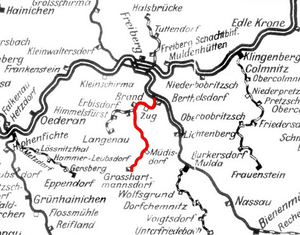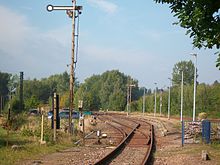Berthelsdorf – Großhartmannsdorf railway line
| Berthelsdorf (Erzgeb) –Großhartmannsdorf | |||||||||||||||||||||||||||||||||||||||||||||||||||||||||||||||||
|---|---|---|---|---|---|---|---|---|---|---|---|---|---|---|---|---|---|---|---|---|---|---|---|---|---|---|---|---|---|---|---|---|---|---|---|---|---|---|---|---|---|---|---|---|---|---|---|---|---|---|---|---|---|---|---|---|---|---|---|---|---|---|---|---|---|
|
Excerpt from the route map of Saxony 1902
| |||||||||||||||||||||||||||||||||||||||||||||||||||||||||||||||||
| Route number (DB) : | 6616; sä. BGh | ||||||||||||||||||||||||||||||||||||||||||||||||||||||||||||||||
| Course book section (DB) : | 515 (1997) | ||||||||||||||||||||||||||||||||||||||||||||||||||||||||||||||||
| Route length: | 11.932 km | ||||||||||||||||||||||||||||||||||||||||||||||||||||||||||||||||
| Gauge : | 1435 mm ( standard gauge ) | ||||||||||||||||||||||||||||||||||||||||||||||||||||||||||||||||
| Maximum slope : | 17 ‰ | ||||||||||||||||||||||||||||||||||||||||||||||||||||||||||||||||
| Minimum radius : | 200 m | ||||||||||||||||||||||||||||||||||||||||||||||||||||||||||||||||
| Top speed: | 50 km / h | ||||||||||||||||||||||||||||||||||||||||||||||||||||||||||||||||
|
|||||||||||||||||||||||||||||||||||||||||||||||||||||||||||||||||
The Berthelsdorf – Großhartmannsdorf railway is a branch line in Saxony that is only partially in operation today. It branches off the Nossen – Moldau railway line in Berthelsdorf and runs through the southern part of the Freiberg-Brander mining area via Brand-Erbisdorf to Großhartmannsdorf .
history
prehistory
The mining companies based in the south of the Freiberg-Brander mining area, such as B. the important Himmelsfürst treasure trove tried very early on a connection to the railway network. Above all, the dispatch of the mined ores, but also the receipt of the acids required in the mining industry for the processing of the ores, was laborious and expensive on the road.
In 1881 a railway construction committee applied to the Saxon state parliament to build a railway line from Berthelsdorf (Erzgeb) via Brand , Langenau (Sachs) , Großhartmannsdorf , Großwaltersdorf to Eppendorf . The line would have connected the Nossen – Moldau railway with the Reitzenhain – Flöha railway. However, the plan was rejected.
As a result of the introduction of the gold standard in 1870 and the resulting decline in the price of silver , the economic situation of the Freiberg silver mines deteriorated rapidly. In order to counteract the closure of the pits and the dismissal of several thousand miners, the state bought the most important mines in 1886 in order to continue operations after their technical modernization. Against this background, the state itself now developed an interest in creating a rail link.
On December 22nd, 1887, the state parliament approved the execution of the regular-gauge secondary railways Berthelsdorf (Erzgeb) –Großhartmannsdorf, Brand-Erbisdorf – Langenau (Sachs) and Freiberg – Halsbrücke . In the explanations of the construction it says, among other things, ... that it is in the interest of the localities involved and that of the fiscal ore mines, instead of the line planned in 1881, initially the construction of a railway from Berthelsdorf to Brand and from to bring to the embodiment here, on the one hand by Großhartmannsdorf, on the other hand to Langenau ... . A total of 3,043,000 marks were planned as the budget . The ordinance for the construction and operation of the Berthelsdorf – Großhartmannsdorf line was issued on December 21, 1889.
Construction and opening
In July 1889, construction work began on the route from Berthelsdorf (Erzgeb) to Großhartmannsdorf and on the branching route to Langenau (Sachs) . Since hardly any major engineering structures had to be erected, the routes were completed after a year of construction. The new secondary line was opened on July 13, 1890 together with the branching line to Langenau (Sachs) and the Freiberg – Halsbrücke line north of Freiberg .
business
The timetable from 1894 indicated a total of four pairs of trains on the entire route, all of which were connected to and from Freiberg. Another train with no return service ran from Brand to Freiberg. The uphill travel time was between 51 and 53 minutes, which corresponded to a cruising speed of around 20 km / h. The timetable was then significantly compressed under the direction of the Deutsche Reichsbahn, when the trains from and to Langenau (Sachs) to Freiberg were also tied through. In the 1939 timetable there were up to six pairs of trains on the Freiberg (Sachs) –Großhartmannsdorf route, which were supplemented by another five on the Freiberg (Sachs) –Langenau (Sachs) route.
On December 2, 1973, travel between Brand-Erbisdorf and Großhartmannsdorf was given up in favor of faster bus connections on what is now federal highway 101 . In freight traffic, the siding of the seating furniture factory was still used until 1975, then the track was dismantled from kilometer 6.65. However, the route between Berthelsdorf and Brand-Erbisdorf remained fully operational for passenger and freight traffic.
The last highlight in the existence of the line was the 100th anniversary celebration between July 14th and 20th, 1990. In addition to a vehicle exhibition in Brand-Erbisdorf, several special trains hauled by steam locomotives ran.
The political change in eastern Germany in 1989/90 finally led to a significant slump in the transport services provided. On June 1, 1997, the remaining travel services on the Freiberg (Sachs) - Langenau (Sachs) route were discontinued. With the exception of the press and forge in Brand-Erbisdorf, all of the goods customers gradually broke away. The resumption of travel between Freiberg-Brand-Erbisdorf between August 28, 1997 and May 23, 1998 remained an intermezzo, as the responsible Free State of Saxony failed to cancel travel.
In May 2000, the remaining Berthelsdorf – Brand-Erbisdorf railway infrastructure was transferred to the private railway infrastructure company RP-Eisenbahn for a 20-year lease . The remaining freight traffic for the press and forge plant came to a standstill in 2012.
For the Bergstadt Festival in Freiberg on June 25 and 26, 2016, passenger trains ran between Freiberg and Brand-Erbisdorf for the first time since 1998. The special trips were organized by the interest group “Perspectives on the Preservation of the Freiberg – Holzhau Railway”. A historic train from the Railway Construction and Operating Company Pressnitztalbahn (PRESS) was used.
Route description
course
The line begins at Berthelsdorf station on the Nossen – Moldau railway line and initially heads west through the Freiberg-Brander mountain area to Brand-Erbisdorf. The other, now disused route led from Brand-Erbisdorf in a southerly direction, with the route essentially following the Kohlbach-Kunstgraben - a mine water channel . The Großhartmannsdorf terminus was north of the town center on today's federal highway 101.
Operating points
Berthelsdorf (Erzgeb) ⊙
The station Berthelsdorf (Erzgeb) existed as a stop since the opening of the Nossen – Bienenmühle line in 1875. After the construction of the branching line from Berthelsdorf – Großhartmannsdorf, the station was elevated to a station in 1905. It had the following names:
- until 1893: Berthelsdorf
- until 1899: Berthelsdorf near Brand
- until 1911: Berthelsdorf i Erzgeb
- since 1911: Berthelsdorf (Erzgeb)
Train ⊙
The train stop was established on May 1, 1901. Not far from the stop, the almost two kilometer long connecting line built in the 1960s for the lamp manufacturer NARVA Brand-Erbisdorf began. From 1984 onwards, there was a company-owned, but public, container station . On May 24, 1998, the breakpoint was taken out of service. The tracks and the waiting hall are still available on site.
Brand-Erbisdorf ⊙
The Brand-Erbisdorf Station is the largest train station in the track. It was put into operation on July 15, 1890. The Brand-Erbisdorf – Langenau railway branched off at Brand-Erbisdorf station. The station had the following names:
- until 1911: Fire near Freiberg
- until 1912: Brand b Freiberg (Sa)
- since 1912: Brand-Erbisdorf (1912: union of Brand and Erbisdorf)
Since the end of passenger traffic in 1998, the station has only been used for freight traffic. The connecting line of the press and forge works, the last remaining freight customer on the route, begins right at the station.
Müdisdorf ⊙
The Müdisdorf stop was opened on July 15, 1890. It was a little out of the way in the north-west near the Kohlbach-Kunstgraben. On December 3, 1973, the station went out of service. Today only the "Bahnweg" in Müdisdorf reminds of the former stop.
Großhartmannsdorf ⊙
The Großhartmannsdorf stop was opened on July 15, 1890 and dedicated to the station in 1905. It was located directly on today's Bundesstrasse 101 ( Silberstrasse ). On December 3, 1973, the station went out of service. The reception building, the goods shed and other farm buildings have been preserved at the site to the present day. The station restaurant still invites you to visit today.
Vehicle use
In the first years of operation, all traffic was handled with the double-coupled secondary rail locomotives of type VII T. The stationing of the KIRCHWEGR locomotive in Großhartmannsdorf is documented. Later, the Royal Saxon State Railways also used class IIIb and VT locomotives , which were dispensable on other routes. Formerly Prussian T 9.3s (91 series) were used by the Deutsche Reichsbahn from the end of the twenties and were replaced by the 86 series in the 1960s . Since the 1970s, all traffic has been handled with the diesel locomotives of the DR class 110 (later class 202). DB Schenker Rail used class 298 and 294 locomotives in the remaining freight transport .
literature
- Thomas Berger: 100 years of Berthelsdorf-Langenau and Freiberg-Halsbrücke . in: Modellisenbahner No. 7/1990, transpress Verlagsgesellschaft mbH i. G. Berlin; Pp. 6-8
- Erich Preuß , Reiner Preuß : Saxon State Railways . transpress Verlagsgesellschaft, Berlin 1991, ISBN 3-344-70700-0 .
Web links
Individual evidence
- ↑ Data on www.sachsenschiene.net
- ^ Thomas Berger: 100 years Berthelsdorf-Langenau and Freiberg-Halsbrücke . in: Modelleisenbahner 39 (1990) 7, p. 6
- ↑ Timetable 1894 of the Saxon State Railways - valid from May 1, 1894
- ↑ Summer timetable 1939 - valid from May 15 to October 7, 1939
- ↑ Modellisenbahner No. 09/2016, Publishing Group Rail, Fürstenfeldbruck
- ^ The Großhartmannsdorf train station on www.sachsenschiene.de
- ^ Website of the inn at the train station in Großhartmannsdorf










